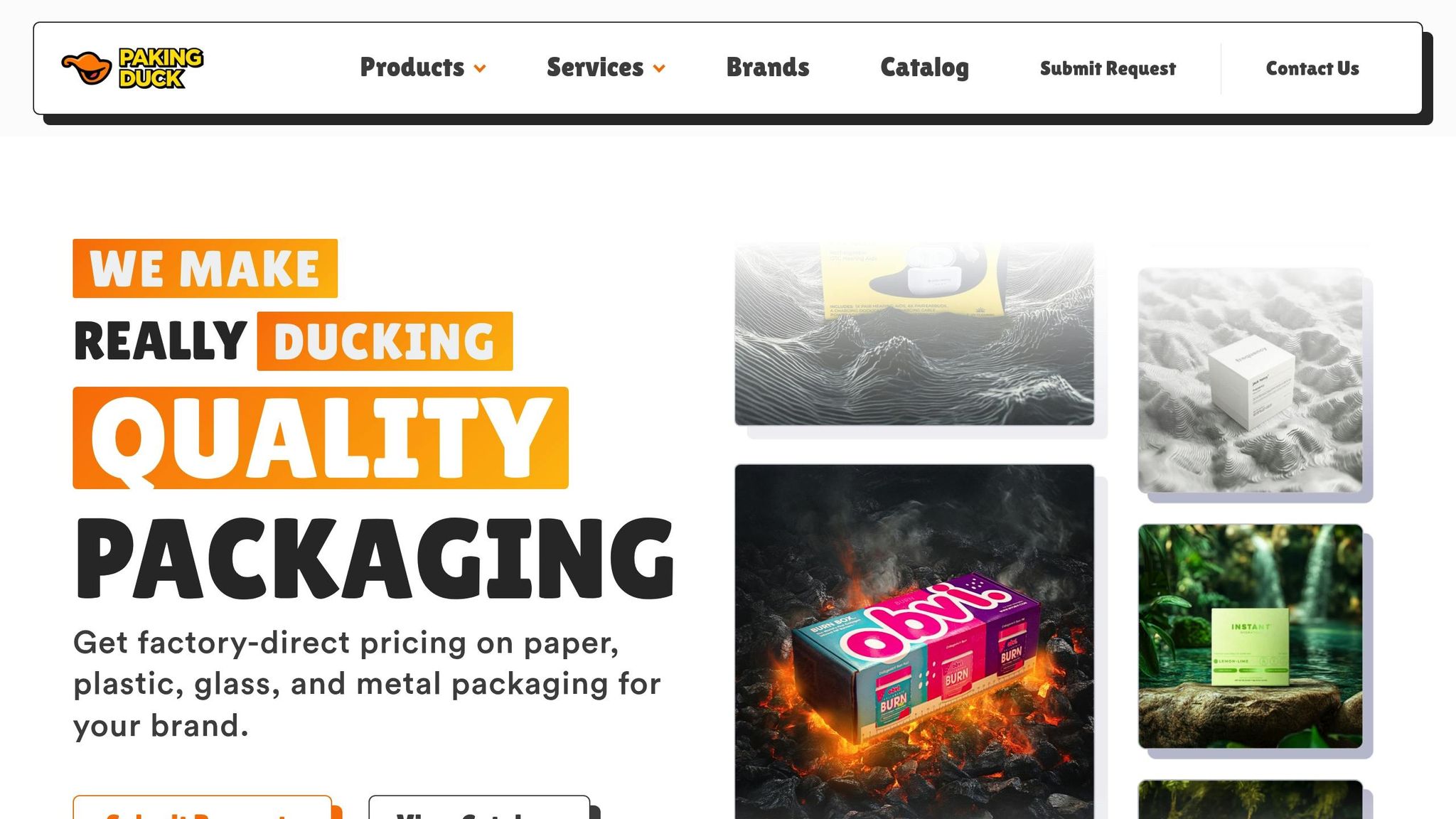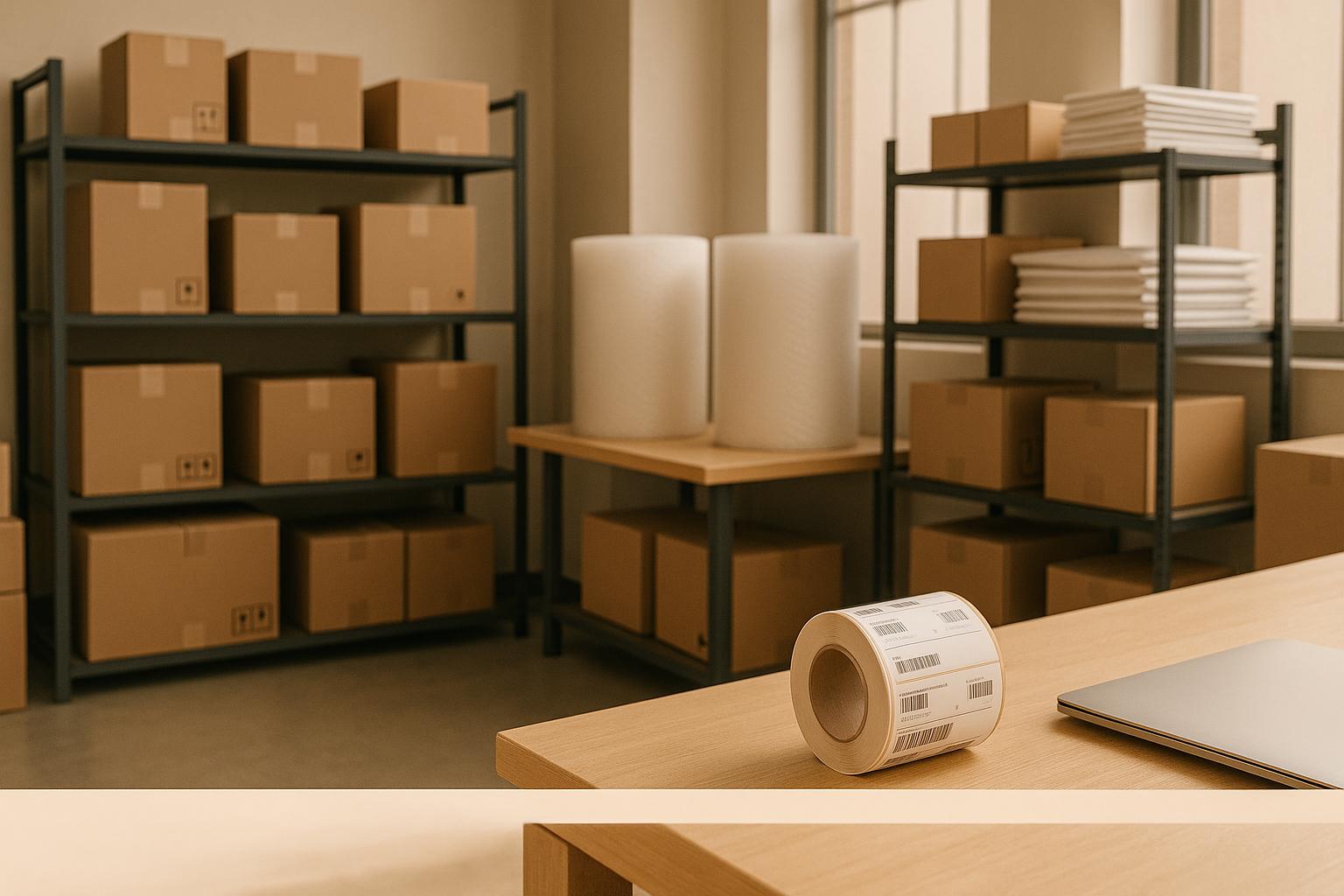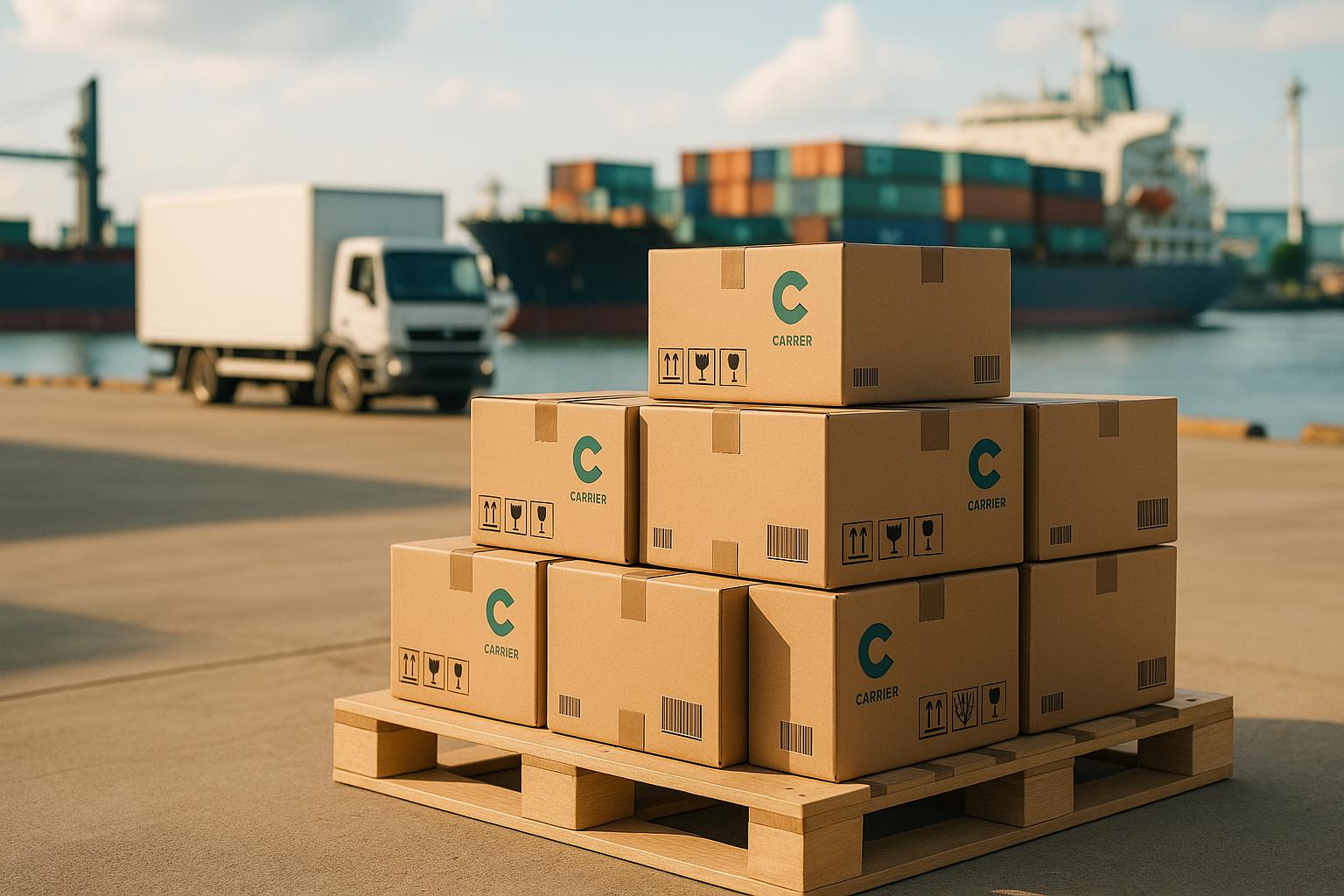Lead time in packaging supply is the total time it takes from placing an order to receiving the final packaging materials. This includes multiple stages like design, production, and shipping. For businesses, managing this timeline is crucial to avoid delays, reduce costs, and meet customer expectations.
Key points include:
- Definition: Lead time covers design, pre-production, manufacturing, and delivery.
- Phases: Steps like graphic design, material sourcing, production, and logistics.
- Factors: Design complexity, supplier location, and material availability directly affect timelines.
- Impact: Delays can disrupt inventory, product launches, and customer satisfaction.
- Solutions: Simplify design, work with expert suppliers, and use digital tools for better planning.
Effectively managing lead times ensures smoother operations, timely product launches, and consistent customer trust.
Lead Time in Packaging Supply Explained
Lead Time Definition
In the world of packaging supply, lead time refers to the entire process from the moment a packaging need is identified to when the customer finally receives the product. This timeline includes several stages: graphic design, prototyping, testing, pre-production, production, post-production, freight to fulfillment, fulfillment itself, and finally, freight to the distributor or retailer. Understanding this comprehensive process is key to managing expectations and ensuring smooth delivery.
Lead Time Phases
The journey from concept to delivery in packaging supply is broken into several essential phases, each playing a critical role:
- Design and Development: This phase kicks off with graphic design, prototyping, and testing to ensure the packaging meets both aesthetic and functional requirements.
- Pre-Production: Here, specifications are finalized, materials are sourced, and equipment is prepared. Suppliers secure raw materials and set up production lines based on approved designs and order quantities.
- Production: The manufacturing process takes center stage, including printing, cutting, forming, and assembly, all under strict quality control measures. Once production wraps up, attention shifts to the next phase.
- Post-Production and Logistics: This involves final touches, thorough quality inspections, and organizing freight to move the products from fulfillment centers to distributors or retailers.
Each of these phases can vary in duration depending on the complexity of the project, the level of customization required, and the capabilities of the supplier. This makes careful planning at every step essential to meet deadlines.
Lead Time Process Example
Let's consider an example of a festival t-shirt vendor preparing for a large festival with 100,000 attendees in August. The vendor plans to sell 15,000 t-shirts. Their lead time breaks down as follows: one business day to complete the shirt design, another day for proofing and design adjustments, a day for printing, and two more business days for shipping. Altogether, the total lead time is five business days.
This example highlights how even straightforward packaging projects involve multiple sequential steps. It underscores the importance of detailed planning to ensure that every phase of the process aligns with the overall timeline.
Lead Time: Definition, How It Works, and Example
Factors That Affect Packaging Lead Time
A variety of factors - like design complexity, supplier location, and material availability - can significantly impact packaging lead times. Understanding these elements is essential for better planning and avoiding costly delays that could disrupt product launches or inventory management.
Packaging Design and Customization
The complexity of your packaging design is a major factor in determining lead times. Simpler designs, such as those using mono-materials, typically involve fewer manufacturing steps and shorter timelines. On the other hand, intricate designs - like multi-component packaging for gift sets or promotional bundles - require more assembly and thorough quality checks, which can extend production time. Additionally, if your packaging isn't compatible with existing machinery, it can create production bottlenecks, adding days or even weeks to the timeline.
Supplier Location and Shipping
Where your supplier is located has a direct impact on delivery times. Domestic suppliers generally offer quicker lead times compared to overseas manufacturers, making it easier to manage production schedules and inventory. International shipments, however, come with extra challenges, including customs clearance delays, peak-season documentation issues, and port congestion, all of which can lead to significant setbacks. Local suppliers also provide the advantage of quicker site visits and faster resolution of issues.
When it comes to shipping methods, there’s a trade-off to consider. Air freight can drastically cut delivery times but is often more expensive, while ocean freight is more cost-effective but slower. According to a Deloitte study, 40% of supply chain companies cite late deliveries as their biggest challenge, and 53% report that supply chain disruptions have a strong to very strong impact on their business.
Another critical factor tied to location is the availability of raw materials, which can further influence lead times.
Material Availability
Shortages in raw materials can cause unpredictable delays, sometimes stretching production timelines by days or even weeks. These shortages, often driven by market fluctuations, can also lead to increased costs. To minimize these risks, diversifying your supplier base and maintaining buffer stocks are effective strategies. The packaging industry has faced significant challenges due to material shortages, which have not only driven up costs but also limited availability.
The financial impact of material availability is hard to ignore. Retailers often spend between 10% and 40% of a product's retail price on packaging, making material costs and availability critical in project planning. A Gartner survey revealed that only 55% of product launches occur on schedule, while 45% experience delays of at least one month. These delays can reduce a company's net present value by 15% to 35%.
sbb-itb-e0a0838
Why Lead Time Matters for CPG Businesses
Packaging lead times might not seem like a big deal at first glance, but they can have a domino effect on inventory management, product launches, and even how customers perceive your brand.
Inventory Management Effects
When lead times are long or unpredictable, companies often feel forced to stockpile extra materials or, worse, halt production altogether. This ties up cash, eats up storage space, and complicates production planning. On the flip side, delays in packaging delivery can lead to finished goods piling up, driving up storage costs and throwing production schedules into chaos. Managing lead times effectively allows for better demand forecasting, which can help cut down on these extra costs and keep things running smoothly. Without this, inventory issues can easily spill over and disrupt product launches.
Product Launch Timing
Speaking of launches, unpredictable lead times can throw a wrench in the works. Delays in packaging can derail carefully planned product debuts, mess up promotional schedules, and cause you to miss key market opportunities. Seasonal products are especially vulnerable - miss the window, and you’re out of luck until next year. Marketing campaigns can also go off the rails if launch dates shift, wasting time and resources while missing the chance to ride the wave of market momentum.
Customer Satisfaction Impact
Lead times don’t just affect internal operations - they directly influence how customers view your brand. When packaging lead times are optimized, products stay in stock, and customers can count on your brand to deliver. This consistency builds trust, which is a big deal in competitive markets. On the other hand, stockouts caused by delays can push customers to try a competitor’s product. Here’s the kicker: 70% of customers who switch brands after a stockout try a competitor, and 40% of them never come back - even when your product is back on shelves.
Reliable packaging delivery does more than just support sales. It strengthens your brand’s reputation, helping you maintain customer loyalty, justify premium pricing, and avoid being seen as unreliable. In a crowded market, that kind of dependability can set you apart from the competition.
How to Reduce Packaging Lead Time
Cutting down packaging lead times isn’t just about working faster - it’s about working smarter. By adopting the right strategies, you can save valuable time without compromising quality. Here’s how to make it happen.
Speed Up Design and Approval
The design phase often turns into a bottleneck, especially when too many people are involved or feedback loops drag on endlessly. To fix this, set up clear approval workflows with firm deadlines for each review stage. Instead of juggling multiple opinions, assign a single point of contact to make final decisions.
Standardizing packaging elements can also be a game-changer. By sticking to consistent dimensions, materials, and printing specifications, you can avoid technical delays. In fact, industry data shows that 50% of packaging professionals found standardization to have the biggest impact on managing their business in 2024.
Another way to streamline the process is by creating design templates and brand guidelines for suppliers. When everyone’s on the same page about colors, fonts, and layout, you can avoid unnecessary revisions and keep the process moving smoothly.
Partner with Expert Suppliers Like Paking Duck

Streamlining design is just one part of the equation. Partnering with experienced suppliers can significantly speed things up. For example, Paking Duck specializes in custom packaging solutions for CPG brands, offering factory-direct pricing that cuts out middleman delays. Their expertise helps you sidestep common design mistakes that can stall production.
With their deep knowledge of materials like paper, plastic, glass, and metal, these specialists can quickly recommend the most efficient production methods for your needs. Plus, when your supplier handles production scheduling and quality control directly, they can prioritize your orders and make on-the-spot adjustments without waiting on third-party approvals.
By eliminating unnecessary handoffs, factory-direct relationships can dramatically reduce production timelines.
Use Forecasting and Digital Tools
To complement streamlined design and expert partnerships, digital tools can take your production planning to the next level. Demand planning software, powered by AI, can analyze historical data to predict your packaging needs months in advance. This gives suppliers more time to prepare materials and schedule production, reducing the need for last-minute rush orders.
These tools also provide real-time visibility into your packaging pipeline, helping you catch potential delays early. According to a survey, nearly 40% of respondents believe automation and digitalization will be a major focus for their business in 2025.
"Turning jobs around faster is not just a competitive advantage, it's a necessity. Customers are asking for shorter lead times and more efficiency, and automation helps compress time-to-market."
- Jan De Roeck, Marketing Director – Industry Relations & Strategy at Esko
Machine learning–based demand sensing adds another layer of efficiency by analyzing real-time customer behavior. This lets you adjust packaging orders based on actual market trends, reducing the risks of overstocking or running out of inventory.
Additionally, digital tools can automate routine tasks like reordering standard packaging components when inventory levels drop. Cloud-based workflow systems also improve collaboration by giving both your team and suppliers access to the latest specifications and updates, cutting down on miscommunication and saving precious time.
Conclusion: Managing Lead Time for Better Results
Managing lead time effectively in packaging supply isn’t just about getting products to market faster - it’s about creating a strong, dependable foundation for your CPG operations. By breaking down the entire process - from design approval to final delivery - you can pinpoint delays and take quick action to address them.
Successful companies focus on every stage of the packaging timeline. They simplify design workflows, build strong relationships with trusted suppliers, and use digital tools to identify and address potential bottlenecks before they become problems. Tracking metrics like average lead time per order and on-time delivery rates is also crucial for making steady improvements.
Balancing speed with predictability offers real value. For instance, having a reliable 12-day lead time is often more beneficial than dealing with unpredictable timelines that vary greatly. This consistency helps you maintain proper inventory levels, stick to product launch schedules, and keep your customers happy.
If you’re looking to make tangible improvements, consider partnering with Paking Duck. With factory-direct pricing and expert support, they can help you avoid design and production delays, keeping your supply chain running smoothly - whether you need corrugated boxes or flexible pouches.
FAQs
How can businesses manage packaging lead times to ensure on-time product launches?
To keep your packaging timelines on track and ensure your product launches go off without a hitch, start planning well in advance - ideally six to eight weeks before your deadline. This window gives you room to handle any hiccups or unforeseen delays.
Some practical steps include prioritizing open communication with your suppliers, streamlining your internal workflows, and fostering reliable partnerships with your vendors. Tools like real-time tracking and consistent updates can help you stay aligned with your schedule. For CPG brands, where even minor delays can affect your position in the market, staying proactive and refining your processes regularly is crucial to maintaining a competitive edge.
How can businesses reduce delays caused by material shortages in packaging supply?
To avoid setbacks caused by material shortages, businesses can take proactive steps like broadening their supplier base. Relying on multiple suppliers instead of just one helps create flexibility when disruptions occur. Strong partnerships with various vendors can make all the difference in maintaining operations smoothly.
Another smart move is leveraging advanced forecasting tools and inventory management systems. These technologies can predict potential shortages, giving businesses a chance to plan ahead. Automating processes, like implementing RFID technology, can also streamline operations, making them more efficient and minimizing delays in packaging timelines.
For more specific strategies, companies such as Paking Duck provide expert consultations and custom packaging solutions. They assist brands in tackling supply chain challenges while keeping costs under control.
How do digital tools and automation help reduce lead times in packaging supply?
Digital tools and automation are game-changers when it comes to shortening lead times in packaging supply. By streamlining repetitive tasks like prepress workflows, production routines, and packaging operations such as sorting, labeling, and packing, automation takes efficiency to a whole new level. It not only speeds up these processes but also reduces the likelihood of human error, keeping things running smoothly.
What’s more, automation brings in features like real-time tracking, predictive maintenance, and seamless collaboration throughout the supply chain. These capabilities help businesses avoid delays, respond quickly to changes, and deliver faster turnaround times - key factors for meeting the fast-paced demands of CPG companies.







.svg.png)